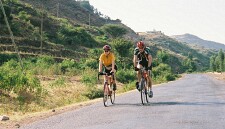 1. Addis Ababa to Debre Birhan (120 km) 1. Addis Ababa to Debre Birhan (120 km)
via Sendafa, Sheno
The road was tarmac all the way to Weldiya. The road rises out of Addis, past Mount Entoto, and rapidly opens out into open countryside.
Debre Birhan is a bustling town, mainly spread along the main street. The old town centre is on the other side of the church and fields from the main road. We ate an excellent dinner in our hotel (Adakulu Hotel), and then sauntered in to the town for coffee in a modern coffee bar (Emanual Pastry) with MTV playing on the TV set in the corner.
At 2,700 metres, Debre Birhan can be very cold when the sun goes down, so make sure you have something warm to wear. |
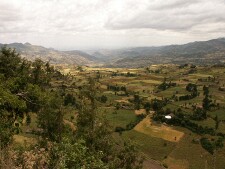 2. Debre Birhan to Ataya (114 km) 2. Debre Birhan to Ataya (114 km)
via Tamaber Pass, Debre Sina, Robit
The road climbs out of Debre Birhan, and there is a stunning view over the Mezezo Escarpment from Tamaber Pass (3230 metres) – a tough start to the day’s cycling. There are spectacular views over the Awash valley to the East.
We stopped at the top of the pass in a roadside hut for a fruit juice (chemaki), and then descended into Debre Sina on the other side; where we had lunch (about 60 km).
About 30km later is Robit, where on Wednesdays you will find a picturesque market selling goods brought from the coast by camel.
We stayed in Ataya, a small village which is also known locally as Eferson, in a truckers’ motel (The Roman Hotel). |
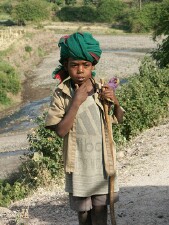 3. Ataya to Dessie (76km) 3. Ataya to Dessie (76km)
via Kembolcha
The road climbs into Karakore, a hillside town where we stopped for coffee (but didn’t see anywhere to stay – Ataya was a better choice), and is then largely flat to Kembolcha. Kembolcha is a busy town, with lots of shops and restaurants. After Kembolcha, the road rises sharply for a very scenic 25km up to Dessie (2500m). This final climb requires considerable fitness.
Dessie is large and modern, and somewhat lacking in charm, but in an attractive setting. You can get to Dessie by air from Addis Ababa (but there are no direct flights to or from Lalibela). |
4. Dessie to Weldiya (100km)
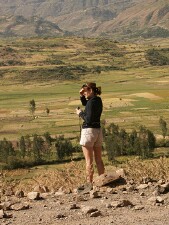 via Hayk, Wuchale and Mersa via Hayk, Wuchale and Mersa
We traveled this stretch by vehicle, as we were heading to Lalibela to meet Virginia. The road is tarmac, but is very hilly, climbing steeply into the mountains, reaching over 3,000m. This would be a long, tough day’s cycling – depending on progress you might need to split the journey at Wuchale. There is a good tourist hotel, the Lal, where we stopped for lunch before turning on to the China Road. The tarmac road finishes in Weldiya – it is gravel from there on.
Weldiya is the birthplace of Al Amoudi – the part-Ethiopian, part-Saudi tycoon who owns a string of commercial interests across Ethiopia, including the Sheraton Hotel in Addis. There are daily buses from Weldiya to Lalibela, taking about 5 hours. |
5. Weldiya to Lalibela – the “China Road” (120km)
via Dilbe, Gashena
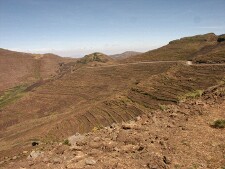 The East-West road between Weldiya and Bahir Dar is known as the China Road because it was built in the 1970s with funds from the Chinese Government. It is a spectacular road, rising up 45km to Dilbe and then running along the top of the ridge to Gashena. We did not attempt this on road bikes; but we think it could be attempted by fit cyclists on mountain bikes (especially if they are not carrying luggage). The East-West road between Weldiya and Bahir Dar is known as the China Road because it was built in the 1970s with funds from the Chinese Government. It is a spectacular road, rising up 45km to Dilbe and then running along the top of the ridge to Gashena. We did not attempt this on road bikes; but we think it could be attempted by fit cyclists on mountain bikes (especially if they are not carrying luggage).
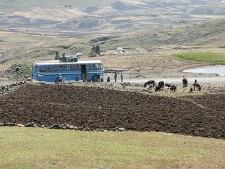 From Gashena to Lalibela is a challenging road requiring 4 wheel drive. There are regular buses from Weldiya, and you can hire 4WD in Weldiya or in Dessie. Alternatively, you could fly: but note that there are no direct flights from Dessie to Lalibela; and in any case, it would be a shame to miss the stunning views along the China Road. From Gashena to Lalibela is a challenging road requiring 4 wheel drive. There are regular buses from Weldiya, and you can hire 4WD in Weldiya or in Dessie. Alternatively, you could fly: but note that there are no direct flights from Dessie to Lalibela; and in any case, it would be a shame to miss the stunning views along the China Road.
Although it adds logistical complications to a cycling holiday, you would be mad to visit Ethiopia and not to go to Lalibela. Though access by bike is difficult, it is worth making arrangements to travel there by 4WD, bus or plane.
We stayed in the New Jerusalem Hotel in Lalibela, which we recommend highly. It has magnificent views over the Lasta Mountains, and a good traditional restaurant. We had a very good meal at the Blue Lal Restaurant (known locally as Chez Sophie, after the owner). |
6. Lalibela to Bahir Dar (by air)
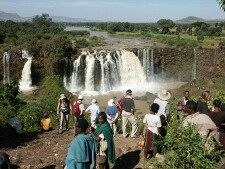 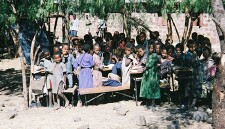 We flew from Lalibela to Bahir Dar. The drive is about 350km along the China Road; and can be done in a long day by bus.We understand that cycling this section of our route would be challenging, and mountain bikes would be necessary, as the road surface is very poor and you would be at high altitude. You could stay over at Debre Tabor and Nefas Mewcha. We would be very interested to hear from anyone who has attempted this by bike. We flew from Lalibela to Bahir Dar. The drive is about 350km along the China Road; and can be done in a long day by bus.We understand that cycling this section of our route would be challenging, and mountain bikes would be necessary, as the road surface is very poor and you would be at high altitude. You could stay over at Debre Tabor and Nefas Mewcha. We would be very interested to hear from anyone who has attempted this by bike.
Bahir Dar is a pleasant lakeside resort, worth spending a day or two. We stayed at the Tana Hotel, part of the Government-owned Ghion chain. This comfortable hotel sits in elaborate wooded grounds on the lake shore. We had good coffee and pastry at the Tana Pastry on the main road. |
7. Bahir Dar to Debra Markos (mainly driving; 30km of cycling)
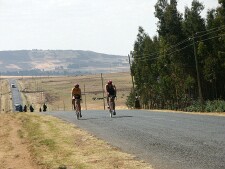 via Dangla, Bure, Dembecha via Dangla, Bure, Dembecha
There was a rough, unmade road to for the first 230km to Emanuel. The road was being built, so more of this stretch may have a hard surface now. It is pretty, rolling countryside on the highland plateau. We cycled from where the tarmac begins, just 30km, to Debre Markos. The unamde sections before Emanuel would be difficult cycling on road bikes, though passable with mountain bikes; you would need to stop on the way – for example at Bure. (On this section, the names of the towns, and the distances between them, did not seem to correspond at all to either of the maps we used.)
Debre Markos is a large town at an altitude of 2515m. There is not much of interest there, however, apart from a church. We stayed at the Shebel Hotel, near the Shell Garage, which was adequate if not very interesting. |
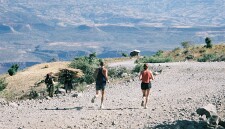 8. Debra Markos to Gohe Tsion 8. Debra Markos to Gohe Tsion
via Dejen (70km), and the Blue Nile Gorge (30km)
There is a good road from Debre Markos to Dejen – largely flat across the beautiful highlands. Dejen is the last town before the road descends into the gorge; there is lots of accommodation here.
The Blue Nile Gorge is apparently the second largest gorge in the world (after the Grand Canyon in the US) and it is spectacular and beautiful. The road is dramatic, especially on the South side of the gorge, when it rises steeply on Italian-built viaducts with dramatic views. The surface is no longer tarmac, and we were unable to cycle on road bikes, so we ran through the gorge instead. It became hotter and more humid as we descended down to the river at the bottom.
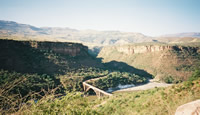 The bridge at the bottom crosses the Blue Nile (locally called the Abay) which winds its way from the source of the Blue Nile at Lake Tana down to Khartoum, in Sudan, where it meets theWhite Nile. This is an important river crossing, so the bridge is guarded by soldiers, and photographs are not allowed. The bridge at the bottom crosses the Blue Nile (locally called the Abay) which winds its way from the source of the Blue Nile at Lake Tana down to Khartoum, in Sudan, where it meets theWhite Nile. This is an important river crossing, so the bridge is guarded by soldiers, and photographs are not allowed.
We stayed at the Hotel Addis in Gohe Tsion, just on the other side of the Gorge. This was the cheapest hotel we stayed in – not least because it was one of the few that did not charge extra for ferenj (ie foreigners). |
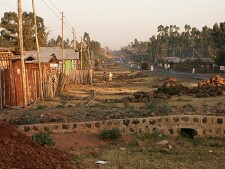 9. Gohe Tsion to Fiche (90km) 9. Gohe Tsion to Fiche (90km)
Once the tarmac restarted, a little beyond Gohe Tsion, this was easy cycling through beautiful countryside and picturesque towns. We stayed at the Alem Hotel on the main road, at the turn-off to Fiche, and did not visit Fiche itself. The Alem is a truck-stop, and well managed hotel, bar, restaurant and probably provides other services to truckers as well. |
10. Fiche to Addis Ababa (90km)
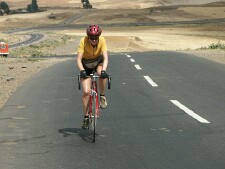 About 10km out of Fiche you cross a bridge, known locally as the Portuguese Bridge (though it isn’t Portuguese), from which you have a teriffic view of the gorge, and where you are likely to see babooons. Just after the bridge is a road leading off to Debre Libanos, which is a 13th Century monastry in a 700 metre canyon, and worth a detour if you have time. From there, the cycling is fast and furious, largely downhill on an excellent tarmac surface, to the outskirts of Addis. About 10km out of Fiche you cross a bridge, known locally as the Portuguese Bridge (though it isn’t Portuguese), from which you have a teriffic view of the gorge, and where you are likely to see babooons. Just after the bridge is a road leading off to Debre Libanos, which is a 13th Century monastry in a 700 metre canyon, and worth a detour if you have time. From there, the cycling is fast and furious, largely downhill on an excellent tarmac surface, to the outskirts of Addis.
As you approach Addis, you will see more and more women carrying huge bundles of firewood. These women trek daily from the city into the surrounding hills to collect wood for fuel and for shelter, as deforestation has reduced the amount of wood available closer to the city. The evidence of spreading deforestation is alarming.
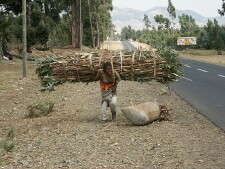 The road comes through the Entoto hills, from where you can coast in to the town. After several days on the dusty roads, the luxuries of the western hotels in Addis can be a welcome relief; but they also seemed excessive and grotesque after the simplicity of life in the countryside. We found that we could no longer enjoy a coffee in the hotel bar, as we had when we first arrived: we had to go out to find a more authentic coffee shop instead. Fortunately, there are plenty in Addis. The road comes through the Entoto hills, from where you can coast in to the town. After several days on the dusty roads, the luxuries of the western hotels in Addis can be a welcome relief; but they also seemed excessive and grotesque after the simplicity of life in the countryside. We found that we could no longer enjoy a coffee in the hotel bar, as we had when we first arrived: we had to go out to find a more authentic coffee shop instead. Fortunately, there are plenty in Addis.
|
 1. Addis Ababa to Debre Birhan (120 km)
1. Addis Ababa to Debre Birhan (120 km) 2. Debre Birhan to Ataya (114 km)
2. Debre Birhan to Ataya (114 km) 3. Ataya to Dessie (76km)
3. Ataya to Dessie (76km) via Hayk, Wuchale and Mersa
via Hayk, Wuchale and Mersa
 From Gashena to Lalibela is a challenging road requiring 4 wheel drive. There are regular buses from Weldiya, and you can hire 4WD in Weldiya or in Dessie. Alternatively, you could fly: but note that there are no direct flights from Dessie to Lalibela; and in any case, it would be a shame to miss the stunning views along the China Road.
From Gashena to Lalibela is a challenging road requiring 4 wheel drive. There are regular buses from Weldiya, and you can hire 4WD in Weldiya or in Dessie. Alternatively, you could fly: but note that there are no direct flights from Dessie to Lalibela; and in any case, it would be a shame to miss the stunning views along the China Road.
 We flew from
We flew from  via Dangla, Bure, Dembecha
via Dangla, Bure, Dembecha  8. Debra Markos to Gohe Tsion
8. Debra Markos to Gohe Tsion The bridge at the bottom crosses the Blue Nile (locally called the Abay) which winds its way from the source of the Blue Nile at Lake Tana down to Khartoum, in Sudan, where it meets theWhite Nile. This is an important river crossing, so the bridge is guarded by soldiers, and photographs are not allowed.
The bridge at the bottom crosses the Blue Nile (locally called the Abay) which winds its way from the source of the Blue Nile at Lake Tana down to Khartoum, in Sudan, where it meets theWhite Nile. This is an important river crossing, so the bridge is guarded by soldiers, and photographs are not allowed. 9. Gohe Tsion to Fiche (90km)
9. Gohe Tsion to Fiche (90km) About 10km out of Fiche you cross a bridge, known locally as the Portuguese Bridge (though it isn’t Portuguese), from which you have a teriffic view of the gorge, and where you are likely to see babooons. Just after the bridge is a road leading off to Debre Libanos, which is a 13th Century monastry in a 700 metre canyon, and worth a detour if you have time. From there, the cycling is fast and furious, largely downhill on an excellent tarmac surface, to the outskirts of Addis.
About 10km out of Fiche you cross a bridge, known locally as the Portuguese Bridge (though it isn’t Portuguese), from which you have a teriffic view of the gorge, and where you are likely to see babooons. Just after the bridge is a road leading off to Debre Libanos, which is a 13th Century monastry in a 700 metre canyon, and worth a detour if you have time. From there, the cycling is fast and furious, largely downhill on an excellent tarmac surface, to the outskirts of Addis. The road comes through the Entoto hills, from where you can coast in to the town. After several days on the dusty roads, the luxuries of the western hotels in Addis can be a welcome relief; but they also seemed excessive and grotesque after the simplicity of life in the countryside. We found that we could no longer enjoy a coffee in the hotel bar, as we had when we first arrived: we had to go out to find a more authentic coffee shop instead. Fortunately, there are plenty in Addis.
The road comes through the Entoto hills, from where you can coast in to the town. After several days on the dusty roads, the luxuries of the western hotels in Addis can be a welcome relief; but they also seemed excessive and grotesque after the simplicity of life in the countryside. We found that we could no longer enjoy a coffee in the hotel bar, as we had when we first arrived: we had to go out to find a more authentic coffee shop instead. Fortunately, there are plenty in Addis.
6 Comments
Tsegaab/ Abita · October 21, 2009 at 10:45 am
I made the 25 day biking tour with 6 groups starting from Debrezeyet or bishoftu, Sodere, Asela, bekoji, Dodola, and three days trekking around dodola, Awassa, wendogenet, Langano, Ziway, Butajira, Buhi, Awash melka and thed Addis Ababa and am a tour guide gratuated from Catering and tourism Training institut have been guiding for about 6 yrs so I fall in love with biking and i want to do more and I do realy thank you for starting this kind of tour to my country.
Best regards
Tsegaab/ Abita
http://www.sunnylandethiopiatours.com
Peter H · May 5, 2011 at 7:36 am
I enjoyed Bahir Dar and stayed at the same hotel a few times including on a memorable night in late June 1987 when Pat Cash won at Wimbeldon. Roads north were a bit more fraught to travel then, especially by bike. But….. we were working and went by plane to /from Addis. Gorge spectacular from the air…….but a little disconcerting on the way back as we were operating on only one engine [of two].
http://abovecapricorn.blogspot.com
Robert · October 9, 2011 at 2:47 pm
I have heard in several places that if you are travelling by bike in Ethiopia, the kids will throw rocks at you, sometimes even with slingshots. Others have said that they run up and try to put sticks through your spokes. Did you have any kind of experience like this?
Ran · May 8, 2012 at 8:48 am
Hi,
Do you know about off-road trails in North Ethiopia around Gondar ? Or a good guide bike who knows around ? Is there any trusted bike company in Addis / Gondar that we can use its facilities for a group of MTB bikers ?
Thanks,
Ran
Tsegaab · May 17, 2012 at 6:15 pm
http://sunnylandethiopiatours.com/bicycle_package.html#tourpckage
I will be the one 🙂
Taddese Atlaw · January 12, 2013 at 2:12 am
Last December we had a group of twenty mountain bikers from Netherlands and Belgium. They stayed with us in Ethiopia for nine days. They bike about 80km/day. The route that we offer them was Addis- Mota- Bahirdar- Blue Nile Falls- Gonder- All semien mountain which is very nice for biking.
For your information, this mountain bikers are very professional and they bike for the last seven years in different country. The confirmed us that their Ethiopia biking tour was the first.
http://www.facebook.com/senait.tours
http://www.senaitethiopia.com/mountainbikingtoethiopia
Thank you,
Taddese Atlaw